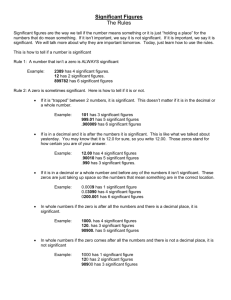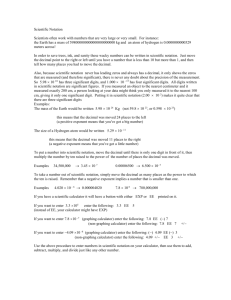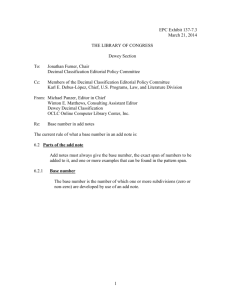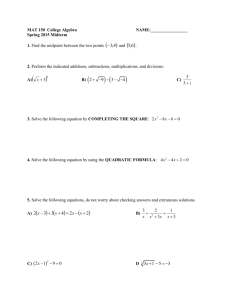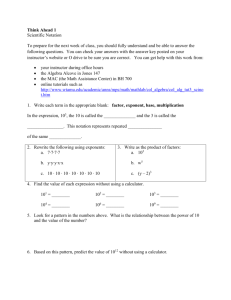7.2 Scientific Notation
advertisement
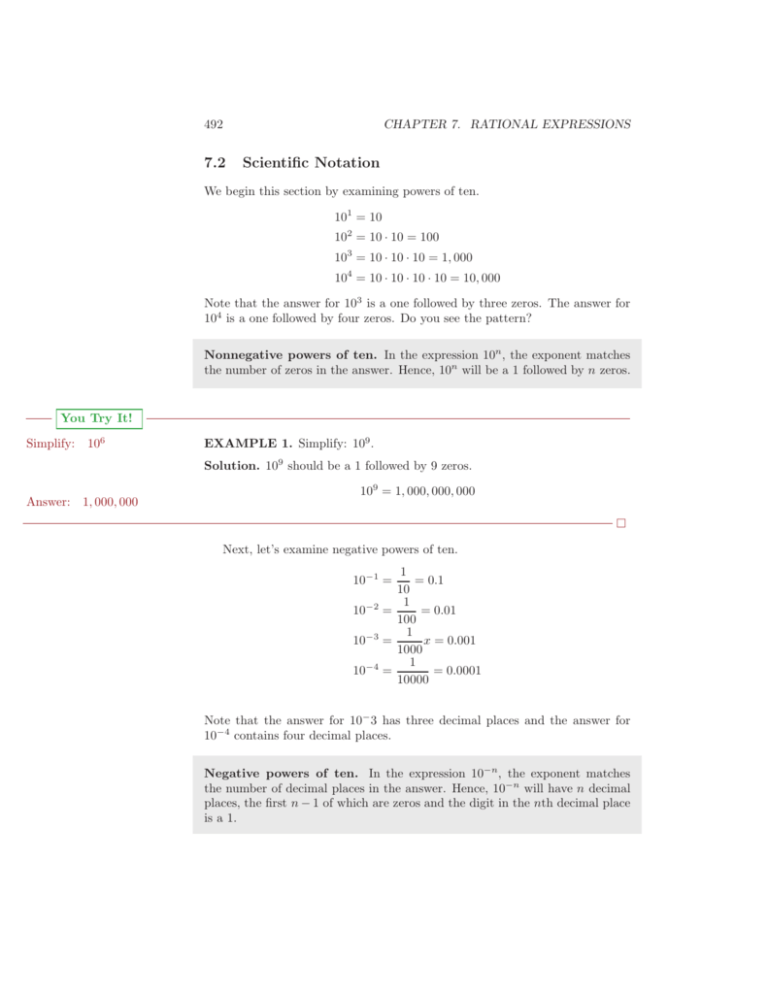
492 7.2 CHAPTER 7. RATIONAL EXPRESSIONS Scientific Notation We begin this section by examining powers of ten. 101 = 10 102 = 10 · 10 = 100 103 = 10 · 10 · 10 = 1, 000 104 = 10 · 10 · 10 · 10 = 10, 000 Note that the answer for 103 is a one followed by three zeros. The answer for 104 is a one followed by four zeros. Do you see the pattern? Nonnegative powers of ten. In the expression 10n , the exponent matches the number of zeros in the answer. Hence, 10n will be a 1 followed by n zeros. You Try It! Simplify: 106 EXAMPLE 1. Simplify: 109 . Solution. 109 should be a 1 followed by 9 zeros. Answer: 1, 000, 000 109 = 1, 000, 000, 000 Next, let’s examine negative powers of ten. 1 = 0.1 10 1 = 0.01 = 100 1 x = 0.001 = 1000 1 = = 0.0001 10000 10−1 = 10−2 10−3 10−4 Note that the answer for 10− 3 has three decimal places and the answer for 10−4 contains four decimal places. Negative powers of ten. In the expression 10−n , the exponent matches the number of decimal places in the answer. Hence, 10−n will have n decimal places, the first n − 1 of which are zeros and the digit in the nth decimal place is a 1. 493 7.2. SCIENTIFIC NOTATION You Try It! EXAMPLE 2. Simplify: 10−7 . Simplify: 10−5 Solution. 10−7 should have seven decimal places, the first six of which are zeros, and the digit in the seventh decimal place is a 1. 10−7 = 0.0000001 Answer: 0.00001 Multiplying Decimal Numbers by Powers of Ten Let’s multiply 1.234567 by 103 , or equivalently, by 1,000. 1.234567 ×1000 1234.567000 The sum total of digits to the right of the decimal point in 1.234567 and 1000 is 6. Therefore, we place the decimal point in the product so that there are six digits to the right of the decimal point. However, the trailing zeros may be removed without changing the value of the product. That is, 1.234567 times 1000 is 1234.567. Note that the decimal point in the product is three places further to the right than in the original factor. This observation leads to the following result. Multiplying by a nonnegative power of ten. Multiplying a decimal number by 10n , where n = 0, 1, 2, 3, . . . , will move the decimal point n places to the right. You Try It! EXAMPLE 3. Simplify: 325.6783 × 102 . Solution. Multiplying by 102 will move the decimal point two places to the right. Thus: 325.6783 × 102 = 32, 567.83 Simplify: 23.57889 × 103 Answer: 23, 578.89 You Try It! EXAMPLE 4. Simplify: 1.25 × 105 . Simplify: 2.35 × 104 494 CHAPTER 7. RATIONAL EXPRESSIONS Solution. Multiplying by 105 will move the decimal point two places to the right. In this case, we need to add zeros at the end of the number to accomplish moving the decimal 5 places to the right. Answer: 23, 500 1.25 × 105 = 125, 000 Let’s multiply 453.9 by 10−2 , or equivalently, by 0.01. 453.9 ×0.01 4.539 The sum total of digits to the right of the decimal point in 453.9 and 0.01 is 3. Therefore, we place the decimal point in the product so that there are 3 digits to the right of the decimal point. That is, 453.9 × 10−2 = 4.539. Note that the decimal point in the product is two places further to the left than in the original factor. This observation leads to the following result. Multiplying by a negative power of ten. Multiplying a decimal number by 10−n , where n = 1, 2, 3, . . . , will move the decimal point n places to the left. You Try It! Simplify: 3, 854.2 × 10−1 Answer: 385.42 EXAMPLE 5. Simplify: 14, 567.8 × 10−3 . Solution. Multiplying by 10−3 will move the decimal point three places to the left. Thus: 14, 567.8 × 10−3 = 14.5678 You Try It! Simplify: 2.2 × 10−2 EXAMPLE 6. Simplify: 4.3 × 10−4 . Solution. Multiplying by 10−4 will move the decimal point four places to the left. In this case, we need to add some leading zeros at the beginning of the number to accomplish moving the decimal 4 places to the left. 4.3 × 10−4 = 0.00043 Answer: 0.022 Note also the leading zero before the decimal point. Although .00043 is an equivalent number, the form 0.00043 is preferred in mathematics and science. 495 7.2. SCIENTIFIC NOTATION Scientific Notation Form We start by defining the form of a number called scientific notation. Scientific notation. A number having the form a × 10b , where b is an integer and 1 ≤ |a| < 10, is said to be in scientific notation. The requirement 1 ≤ |a| < 10 says that the magnitude of a must be a least 1 and less than 10. • The number 12.34 × 10−4 is not in scientific notation because |12.34| = 12.34 is larger than 10. • The number −0.95 × 103 is not in scientific notation because | − 0.95| = 0.95 is less than 1. • The number 7.58 × 10−12 is in scientific notation because |7.58| = 7.58 is greater than or equal to 1 and less than 10. • The number −1.0 × 1015 is in scientific notation because | − 1.0| = 1.0 is greater than or equal to 1 and less than 10. After contemplating these examples, it follows that a number in scientific notation should have exactly one of the digits 1, 2, 3, . . . , 9 before the decimal point. Exactly one, no more, no less. Thus, each of the following numbers is in scientific notation. 4.7 × 108 , −3.764 × 10−1 , 3.2 × 100 , and − 1.25 × 10−22 Placing a Number in Scientific Notation To place a number into scientific notation, we need to move the decimal point so that exactly one of the digits 1, 2, 3, . . . , 9 remains to the left of the decimal point, then multiply by the appropriate power of 10 so that the result is equivalent to the original number. You Try It! EXAMPLE 7. Place the number 1,234 in scientific notation. Solution. Move the decimal point three places to the left so that it is positioned just after the 1. To make this new number equal to 1,234, multiply by 103 . Thus: 1, 234 = 1.234 × 103 Place the number 54,321 in scientific notation. 496 CHAPTER 7. RATIONAL EXPRESSIONS Check: Multiplying by 103 moves the decimal three places to the right, so: 1.234 × 103 = 1, 234 Answer: 5.4321 × 104 This is the original number, so our scientific notation form is correct. You Try It! Place the number 0.0175 in scientific notation. EXAMPLE 8. Place the number 0.000025 in scientific notation. Solution. Move the decimal point five places to the right so that it is positioned just after the 2. To make this new number equal to 0.000025, multiply by 10−5 . Thus: 0.000025 = 2.5 × 10−5 Check: Multiplying by 10−5 moves the decimal five places to the left, so: 2.5 × 10−5 = 0.000025 Answer: 1.75 × 10−2 This is the original number, so our scientific notation form is correct. You Try It! Place the number 756.98 × 10−5 in scientific notation. EXAMPLE 9. Place the number 34.5 × 10−11 in scientific notation. Solution. First, move the decimal point one place to the left so that it is positioned just after the three. To make this new form equal to 34.5, multiply by 101 . 34.5 × 10−11 = 3.45 × 101 × 10−11 Now, repeat the base 10 and add the exponents. = 3.45 × 10−10 Answer: 7.5698 × 10−3 You Try It! Place the number 0.00824 × 108 in scientific notation. EXAMPLE 10. Place the number 0.00093 × 1012 in scientific notation. Solution. First, move the decimal point four places to the right so that it is positioned just after the nine. To make this new form equal to 0.00093, multiply by 10−4 . 0.00093 × 1012 = 9.3 × 10−4 × 1012 497 7.2. SCIENTIFIC NOTATION Now, repeat the base 10 and add the exponents. = 9.3 × 108 Answer: 8.24 × 105 Scientific Notation and the Graphing Calculator The TI-84 graphing calculator has a special button for entering numbers in scientific notation. Locate the “comma” key just about the number 7 key on the calculator’s keyboard (see Figure 7.1). Just above the “comma” key, printed on the calculator’s case is the symbol EE. It’s in the same color as the 2nd key, so you’ll have to use the 2nd key to access this symbol. Figure 7.1: Locate the EE label above the “comma” key on the keyboard. We know that 2.3 × 102 = 230. Let’s see if the calculator gives the same interpretation. 1. Enter 2.3. 2. Press the 2nd key, then the comma key. This will put E on the calculator view screen. 3. Enter a 2. 4. Press ENTER. The result of these steps is shown in the first image in Figure 7.2. Note that the calculator interprets 2.3E2 as 2.3 × 102 and gives the correct answer, 230. You can continue entering numbers in scientific notation (see the middle image in Figure 7.2). However, at some point the numbers become too large and the calculator responds by outputting the numbers in scientific notaiton. You can also force your calculator to display numbers in scientific notation in all situations, by first pressing the MODE key, then selecting SCI on the first 498 CHAPTER 7. RATIONAL EXPRESSIONS Figure 7.2: Entering numbers in scientific notation. line and pressing the ENTER key (see the third image in Figure 7.2). You can return your calculator to “normal” mode by selecting NORMAL and pressing the ENTER key. You Try It! Use the graphing calculator to simplify: EXAMPLE 11. Use the graphing calculator to simplify: (2.35 × 10−12 )(3.25 × 10−4 ) (3.42 × 106 )(5.86 × 10−9 ) Solution. First, note that we can approximate (2.35 × 10−12)(3.25 × 10−4) by taking the product of 2 and 3 and adding the powers of ten. (2.35 × 10−12 )(3.25 × 10−4 ) ≈ (2 × 10−12 )(3 × 10−4 ) Approximate: 2.35 ≈ 2 and 3.25 ≈ 3. ≈ 6 × 10 2 · 3 = 6 and 10−12 · 10−4 = 10−16 . −16 The graphing calculator will provide an accurate answer. Enter 2.35E-12, press the “times” button, then enter 3.25E-4 and press the ENTER button. Be sure to use the “negate” button and not the “subtract” button to produce the minus sign. The result is shown in Figure 7.3. Figure 7.3: Computing (2.35 × 10−12 )(3.25 × 10−4 ). Answer: 2.00412 × 10 −2 Thus, (2.35 × 10−12)(3.25 × 10−4) = 7.6375 × 10−16. Note that this is fairly close to our estimate of 6 × 10−16 . 499 7.2. SCIENTIFIC NOTATION Reporting your answer on your homework. After computing the answer to Example 11 on your calculator, write the following on your homework: (2.35 × 10−12 )(3.25 × 10−4 ) = 7.6375 × 10−16 Do not write 7.6375E-16. You Try It! EXAMPLE 12. Use the graphing calculator to simplify: 6.1 × 10−3 (2.7 × 104 )(1.1 × 108 ) Use the graphing calculator to simplify: 2.6 × 104 (7.1 × 10−2 )(6.3 × 107 ) Solution. Again, it is not difficult to produce an approximate answer. 6.1 × 10−3 (2.7 × 104 )(1.1 × 108 ) 6 × 10−3 ≈ (3 × 104 )(1 × 108 ) 6 × 10−3 ≈ 3 × 1012 6 10−3 ≈ · 12 3 10 ≈ 2 × 10−15 6.1 ≈ 6, 2.7 ≈ 3, and 1.1 ≈ 1. 3 · 1 = 3 and 104 · 108 = 1012 . ac a c = · . bd b d 6 10−3 = 2 and = 10−15 . 3 1012 Let’s get a precise answer with our calculator. Enter the numerator as 6.1E3, then press the “division” button. Remember that we must surround the denominator with parentheses. So press the open parentheses key, then enter 2.7E4. Press the “times” key, then enter 1.1E8. Press the close parentheses key and press the ENTER button. The result is shown in Figure 7.4. Figure 7.4: Computing 6.1 × 10−3 /(2.7 × 104 × 1.1 × 108 ). Thus, 6.1 × 10−3 /(2.7 × 104 × 1.1 × 108 ) = 2.05387205 × 10−15 . Note that this is fairly close to our estimate of 2 × 10−15 . Answer: 5.8126537 × 10−3 500 CHAPTER 7. RATIONAL EXPRESSIONS You Try It! The mass of the International Space Station is 450,000 kg, and its average distance to the center of the earth is 387,000 m. Find the force of attraction between the earth and the station (in newtons (N)). EXAMPLE 13. the formula Isaac Newton’s universal law of gravitation is defined by GmM r2 where F is the force of attraction between two objects having mass m and M , r is the distance between the two objects, and G is Newton’s gravitational constant defined by: F = G = 6.67428 × 10−11 N(m/kg)2 Given that the mass of the moon is 7.3477 × 1022 kilograms (kg), the mass of the earth is 5.9736 × 1024 kilograms (kg), and the average distance between the moon and the earth is 3.84403 × 108 meters (m), find the force of attraction between the earth and the moon (in newtons (N)). Solution. Plug the given numbers into Newton’s universal law of gravitation. GmM r2 (6.673 × 10−11 )(7.3477 × 1022 )(5.9736 × 1024 ) F = (3.84403 × 108 )2 F = Enter the expression into your calculator (see Figure 7.5) as: (6.673E-11*7.3477E22*5.9736E24)/(3.84403E8)∧2. Figure 7.5: Computing force of attraction between earth and the moon. Answer: ≈ 1.20 × 109 N Hence, the force of attraction between the earth and the moon is approximately 1.98 × 1020 newtons (N). You Try It! The star Sirius is 8.58 light-years from the earth. How many miles from the earth is Sirius? EXAMPLE 14. The closest star to the earth is Alpha Centauri, 4.37 lightyears from the earth. A light-year is the distance that light will travel in 7.2. SCIENTIFIC NOTATION 501 one-year’s time. The speed of light is 186,000 miles per second. How many miles from the earth is Alpha Centauri? Solution: Because the speed of light is measured in miles per second, let’s first compute the number of seconds in 4.37 years. Because there are 365 days in a year, 24 hours in a day, 60 minutes in an hour, and 60 seconds in a minute, we can write: day hr min s 4.37 yr = 4.37 yr × 365 × 24 × 60 × 60 yr day hr min r day h min s = 4.37 yr × 60 × 60 × 365 yr × 24 day r h min Note how the units cancel, indicating that the final answer is in seconds. With our calculator mode set to scientific notation (see the image on the right in Figure 7.2), we multiply the numbers to get the result shown in Figure 7.6. Rounding, the number of seconds in 4.37 years is approximately 1.38 × 108 seconds. Next, we compute the distance the light travels in 4.37 years. Using the fact that the distance traveled equals the speed times the time traveled, we have: Distance = Speed × Time mi = 1.86 × 105 · 1.38 × 108 s s mi · 1.38 × 108 s = 1.86 × 105 s Note how the units cancel, indicating that our answer is in miles. Again, with our calculator set in scientific notation mode, we compute the product of 1.86 × 105 and 1.38 × 108 . The result is shown in the image on the right in Figure 7.6. Figure 7.6: Computing the distance to Alpha Centauri in miles. Thus, the star Alpha Centauri is approximately 2.5668 × 1013 miles from the earth, or 2.5668 × 1013 miles ≈ 25, 668, 000, 000, 000 miles, pronounced “twenty-five quadrillion, six hundred sixty-eight trillion miles.” Answer: ≈ 5.2425 × 1013 miles 502 CHAPTER 7. RATIONAL EXPRESSIONS ❧ ❧ ❧ Exercises ❧ ❧ ❧ In Exercises 1-8, write each of the following in decimal format. 1. 10−4 5. 108 2. 10−13 6. 1014 3. 10−8 7. 107 4. 10−9 8. 109 In Exercises 9-16, write each of the following in decimal format. 9. 6506399.9 × 10−4 13. 440906.28 × 10−4 10. 19548.4 × 10−2 14. 9147437.4 × 10−4 11. 3959.430928 × 102 15. 849.855115 × 104 12. 976.841866 × 104 16. 492.4414 × 103 In Exercises 17-24, convert each of the given numbers into scientific notation. 17. 390000 21. 0.81 18. 0.0004902 22. 83400 19. 0.202 23. 0.0007264 20. 3231 24. 0.00395 In Exercises 25-32, convert each of the given expressions into scientific notation. 25. 0.04264 × 10−4 29. 30.04 × 105 26. 0.0019 × 10−1 30. 76000 × 10−1 27. 130000 × 103 31. 0.011 × 101 28. 738 × 10−1 32. 496000 × 10−3 503 7.2. SCIENTIFIC NOTATION In Exercises 33-38, each of the following numbers are examples of numbers reported on the graphing calculator in scientific notation. Express each in plain decimal notation. 33. 1.134E -1 36. 1.802E 4 34. 1.370E -4 37. 1.748E -4 35. 1.556E -2 38. 1.402E 0 In Exercises 39-42, first, use the technique of Example 11 to approximate the given product without the use of a calculator. Next, use the MODE button to set you calculator in SCI and FLOAT mode, then enter the given product using scientific notation. When reporting your answer, report all digits shown in your calculator view screen. 39. (2.5 × 10−1 )(1.6 × 10−7 ) 41. (1.4 × 107 )(1.8 × 10−4 ) 40. (2.91 × 10−1 )(2.81 × 10−4 ) 42. (7.48 × 107 )(1.19 × 106 ) In Exercises 43-46, first, use the technique of Example 12 to approximate the given quotient without the use of a calculator. Next, push the MODE button, then highlight SCI mode and press ENTER. Move your cursor to the same row containing the FLOAT command, then highlight the number 2 and press ENTER. This will round your answers to two decimal places. Press 2nd MODE to quit the MODE menu. With these settings, enter the given expression using scientific notation. When entering your answer, report all digits shown in the viewing window. 43. 3.2 × 10−5 2.5 × 10−7 45. 5.9 × 103 2.3 × 105 44. 6.47 × 10−5 1.79 × 108 46. 8.81 × 10−9 3.06 × 10−1 47. Overall the combined weight of biological material – animals, plants, insects, crops, bacteria, and so on – has been estimated to be at about 75 billion tons or 6.8 × 1013 kg (http://en.wikipedia. org/wiki/Nature). If the Earth has mass of 5.9736 × 1024 kg, what is the percent of the Earth’s mass that is made up of biomass? 48. The Guinness World Record for the longest handmade noodle was set on March 20, 2011. The 1,704-meter-long stretch of noodle was displayed during a noodle-making activity at a square in Southwest China’s Yunnan province. Meigan estimates that the average width of the noodle (it’s diameter) to be the same as her index finger or 1.5 cm. Using the volume formula for a cylinder (V = πr2 h) estimate the volume of the noodle in cubic centimeters. 504 CHAPTER 7. RATIONAL EXPRESSIONS 49. Assume there are 1.43×106 miles of paved road in the United States. If you could travel at an average of 65 miles per hour nonstop, how many days would it take you to travel over all of the paved roads in the USA? How many years? ❧ ❧ ❧ 50. The population of the USA in mid-2011 was estimated to be 3.12 × 108 people and the world population at that time to be about 7.012 × 109 people. What percentage of the world population live in the USA? Answers ❧ ❧ ❧ 1. 0.0001 27. 1.3 × 108 3. 0.00000001 29. 3.004 × 106 5. 100, 000, 000 31. 1.1 × 10−1 7. 10, 000, 000 33. 0.1134 9. 650.63999 11. 395943.0928 13. 44.090628 15. 8498551.15 35. 0.01556 37. 0.0001748 39. 4 × 10−8 41. 2.52 × 103 17. 3.9 × 105 43. 1.28 × 102 19. 2.02 × 10 −1 45. 2.57 × 10−2 21. 8.1 × 10−1 23. 7.264 × 10−4 25. 4.264 × 10−6 47. 1.14 × 10−11 49. 916.7 days, 2.5 yr

